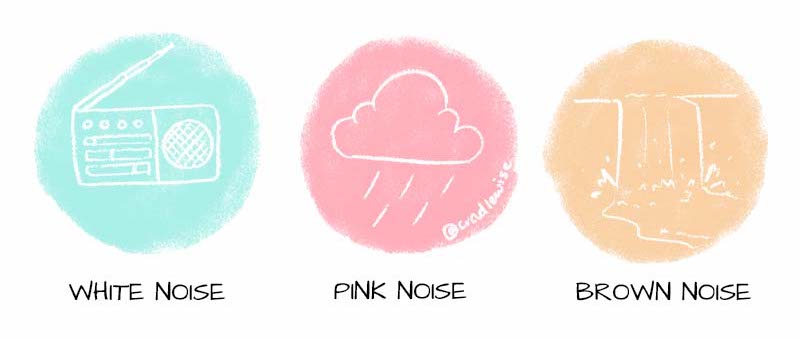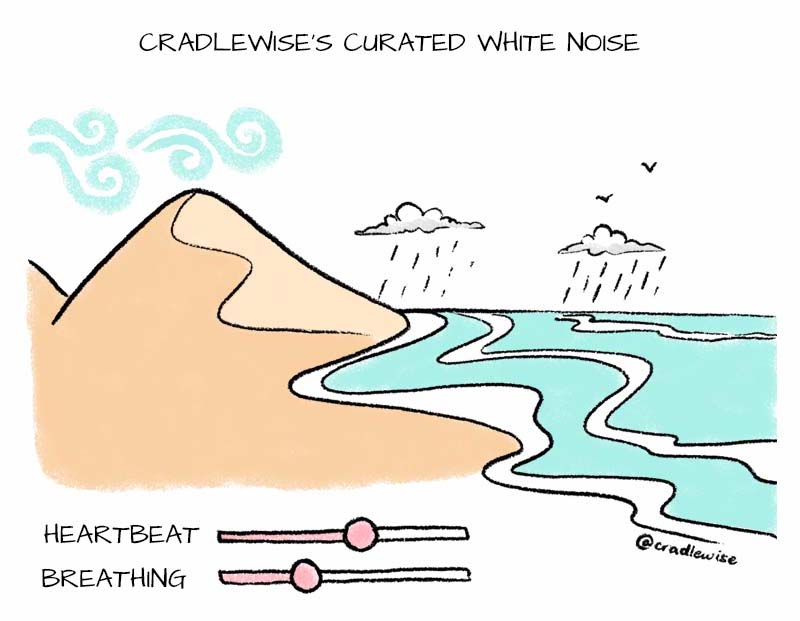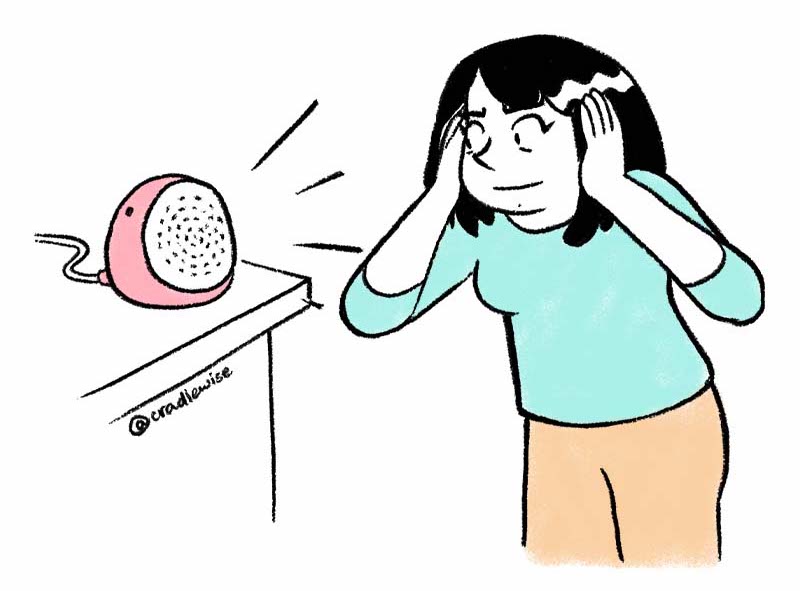Product
0 min read
White noise for babies: Does it help them sleep?

Cradlewise Staff
A womb is a noisy place. And for your baby, this noise is the sound of home.
Your little one struggles to drift into a peaceful sleep in the hushed, unfamiliar silence outside the womb. So how can you give your baby a sonic atmosphere that feels familiar?
The answer is — white noise.
The benefit of white noise is, because it resembles the sounds of the womb, it can help your baby sleep. It creates a blanket of sound around your baby, which masks the external noises that might disturb your little one and wake them up.

What is white noise, and how does it work?
The concept of white noise stems from ‘white light.’ We get white light by combining all the colors of the visible spectrum. In the same way, we get white noise by combining all the different sound frequencies.
It’s great for background noise to mask other sounds. White noise sounds like the static sound of the TV and the constant hum of the air purifier.
You’ve heard of white noise, but what’s pink and brown noise?
White noise can sound a little ear-piercing (like TV static). Pink noise is less intense (like the sound of the wind, steady rain, or the rustling of leaves). On the other hand, Brown noise has more bass in lower frequencies than pink noise. It sounds like a low roar, thunder, or waterfalls.

Brown noise vs pink noise
Do you know that research has shown that noises in the womb are much closer to pink noise than white noise?
Although the scientific research is still developing, we are trying to incorporate pink and brown noise in our crib.
Like white noise, pink and brown noise also consist of all frequencies we can hear. In white noise, the energy is equally distributed across all frequencies.
However, lower frequencies have more energy than the higher frequencies in both pink and brown noise. The energy reduces as the frequency increases. That’s why both of them sound more bass-heavy than white noise.
The difference in sound between pink and brown noise is because of the rate at which the energy reduces as frequency increases.
The energy reduction is faster in brown noise than pink noise, making brown noise sound deeper than pink noise.
How to create customizable sleep tracks in the Cradlewise app

You can customize the white, pink, and brown noise sleep tracks by adding layers of different sounds like heartbeat, wind, and rain to them.
To customize a sleep track:
- Tap on the Sound icon on your bottom navigation bar. In the Sound tab, select the (+) from the top right corner.
- Choose white, pink, or brown noise.
- Choose your preferred ambiance of light rain, heavy rain, soft breeze, or waves.
- Add a subtle sound of heartbeat and/or breathing as per your preference.
- Use the ‘Preview on crib’ button to preview and change your mixed composition to your preference.
- Give your track a name and tap on Save.
Did you know?
Research has shown that pink noise for babies reduces the complexity of brain waves, which induces sound sleep. It helps babies fall into a deeper and longer sleep.

Did you know?
Research has shown that steady pink noise reduces the complexity of brain waves, which induces sound sleep in babies. It helps babies fall into a deeper and longer sleep.
Is brown noise good for babies?
Although there isn’t much concrete research on the effect of brown noise on baby sleep, it is said to help sustain sleep.
Safety guidelines
It’s only natural that the white noise you’re using to drown out and mask the disturbances is loud.
But how loud is too loud?
A 2014 study found that a lot of white noise machines for babies were a little too loud for babies.

What is the recommended range of loudness?
The studies on white noise improving sleep suggest that 70 to 75 dB is a safe volume range to drain out the external noise.
But throwing around numbers and random dB levels can be a little confusing. So we have compiled a list of some common everyday noises and their average decibels to give you the context of what we are talking about when we say ‘safe noise levels.’
Noise | Average decibels (dB) |
Leaves rustling, soft music, whisper | 30 dB |
Average home noise | 40 dB |
Normal conversation, background music | 60 dB |
Office noise, inside the car at 60 mph | 70 dB |
Vacuum cleaner, the average radio | 75 dB |
Heavy traffic, window air conditioner, noisy restaurant, power lawnmower | 80–89 dB (sounds above 85 dB are harmful) |
Subway, shouted conversation | 90–95 dB |
Boom box, ATV, motorcycle | 96–100 dB |
Sports crowd, rock concert, loud symphony | 120–129 dB |
Now, compare the safe noise range suggested above (70 to 75 dB) with the noise levels in the womb, which are around 85 decibels to 95 decibels. We can conclude that it’s a pretty safe range considering babies already hear much louder noises in the womb.
You can, of course, lower the volume after your little one has fallen asleep. But does constantly monitoring the volume levels sound like too much work? Don’t worry. We got you covered.
Our white noise machine saves you the trouble and worries regarding the volume safety of your little one. Our machine’s maximum volume range is 70 dB, which is well within safe limits. So even when turned up to full volume, our crib’s white noise is safe for your baby.
In short, the white noise doesn’t play through the night at the same volume in our crib.
Our white noise machine acts as a helping set of hands, intuitively responding to your little one’s needs in real-time.
Noise turn-off option
Even though our white noise machine regulates the volume per your baby’s need, you can turn it off if you like.
The science behind Cradlewise’s white noise feature
We are constantly striving to incorporate new research findings and elements of artificial intelligence to evolve the white noise experience for your baby’s better sleep.
Location of the speakers and the unique acoustics
The speaker of our white noise machine is placed at the bottom part of the crib. It’s away from the baby, and it’s pointing downwards.
Even on the highest volume, the speaker will be at a safe distance from your baby so you can rest easy knowing that the white noise will not impact your little one’s hearing.
Unique sound effect
When the white noise starts playing, the lower part of our crib will act as a sound chamber, giving the sound a unique effect. The sound doesn’t feel like it’s coming from a single loud point source. Instead, it sounds like it originates from a larger distributed source. So irrespective of your little one’s position in the crib, the sound levels experienced by them will not vary much.

This distributed sound effect happens because the chamber ends up causing the sound energy to escape from all sides and then reach the child instead of directly from the speaker.
AI tracking 3D cameras
Our white noise machine has dynamic volume adjustment, which means it can regulate the volume on its own! The crib has AI tracking 3D cameras which are connected to the mics. The baby monitor senses signs of stirring and starts playing white noise.
Our 3D cameras sense the baby’s movements and automatically turn up the white noise.

So when your baby is fussy, the white noise volume becomes higher. And when he is asleep, the white noise turns lower.
Curated music to help the baby sleep
Most white noise machines for babies have a pretty limited set of tracks. On the other hand, our white noise machine gives you a vast collection of tracks to choose from. These tracks are specially curated to make your baby fall asleep faster and sleep better.
And not just more tracks. We are also working on innovating the good old white noise in our crib by mixing it with the sound of a heartbeat! This noise mimics the sound of the mother’s heartbeat, giving another layer of security and sonic familiarity to your baby.
The bottom line
There’s plenty of research studying the effects of white noise on baby sleep.
White noise resembles the noise babies hear in the womb and thus, sonically feels like home to your baby, helping them fall asleep quickly and more deeply. Pink and brown noise has also been likened to the noises your little one hears in the womb. The effects of these noises are shown to reduce the complexity of brain waves, induce sound sleep in babies, and help in your little one’s memory consolidation.
FAQs
Q: Why does white noise help you sleep?
A: All the frequencies in white noise are at equal intensity. This quality helps its sound mask all the loud noises around you that can stimulate your brain and prevent you from falling asleep.
Q: When to stop using white noise for babies?
A: It’s up to your discretion, based on how well your baby sleeps with white noise. While some parents stop using white noise when their baby is two years old, other parents continue using it until their child is three to four years old.
Q: Are sound machines safe for babies?
A: Recent studies have discovered that the noise levels of some white noise machines exceed the safety limits. However, our white noise machine is perfectly safe and within the safe noise levels.
Learn more:
Sources:
- Pink noise’s effect on baby sleep. PubMed. 2012. “Pink noise: effect on complexity synchronization of brain activity and sleep consolidation.”
- Pink noise and memory consolidation. Neuron. 2013. “Auditory Closed-Loop Stimulation of the Sleep Slow Oscillation Enhances Memory.“
- Noise levels in infant sound machines. AAP. 2014. “Infant Sleep Machines and Hazardous Sound Pressure Levels.“
- Noise levels inside the womb. Obstetrical & Gynecological Survey. 1993. “Loud Noise and Pregnancy.“
- White noise and baby sleep. NCBI. 1990. “White noise and sleep induction.”
You may also like





